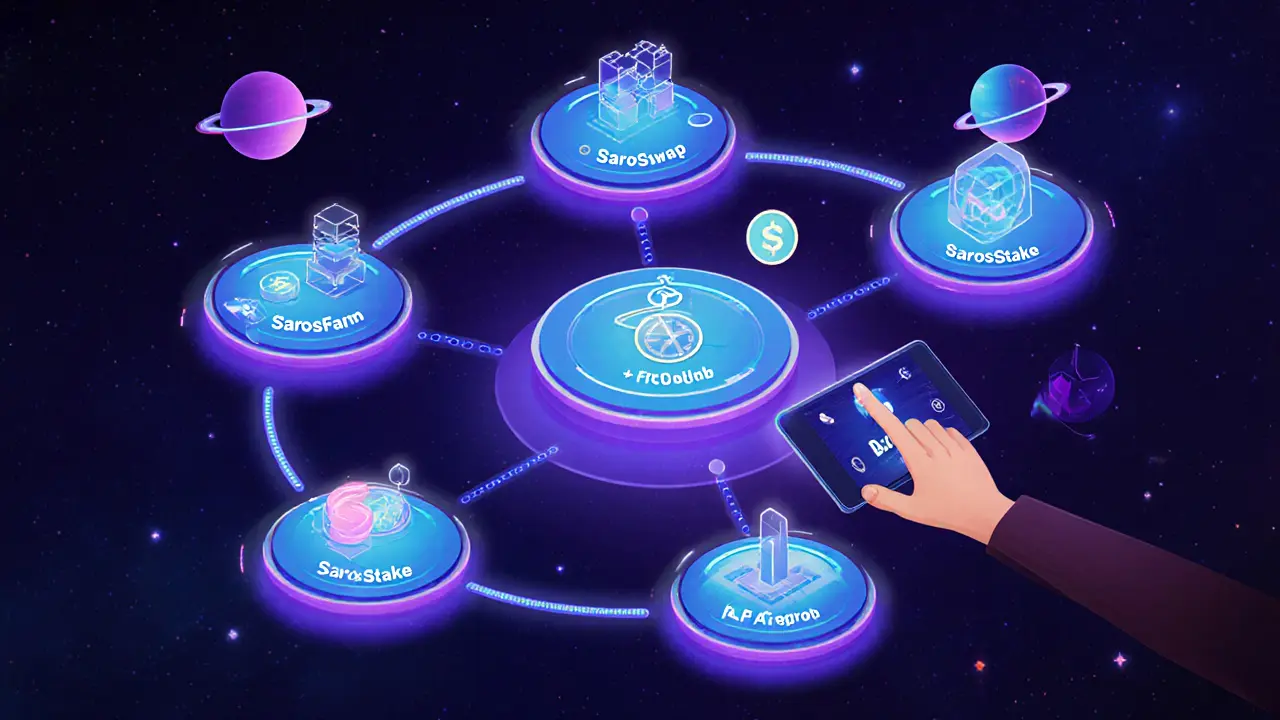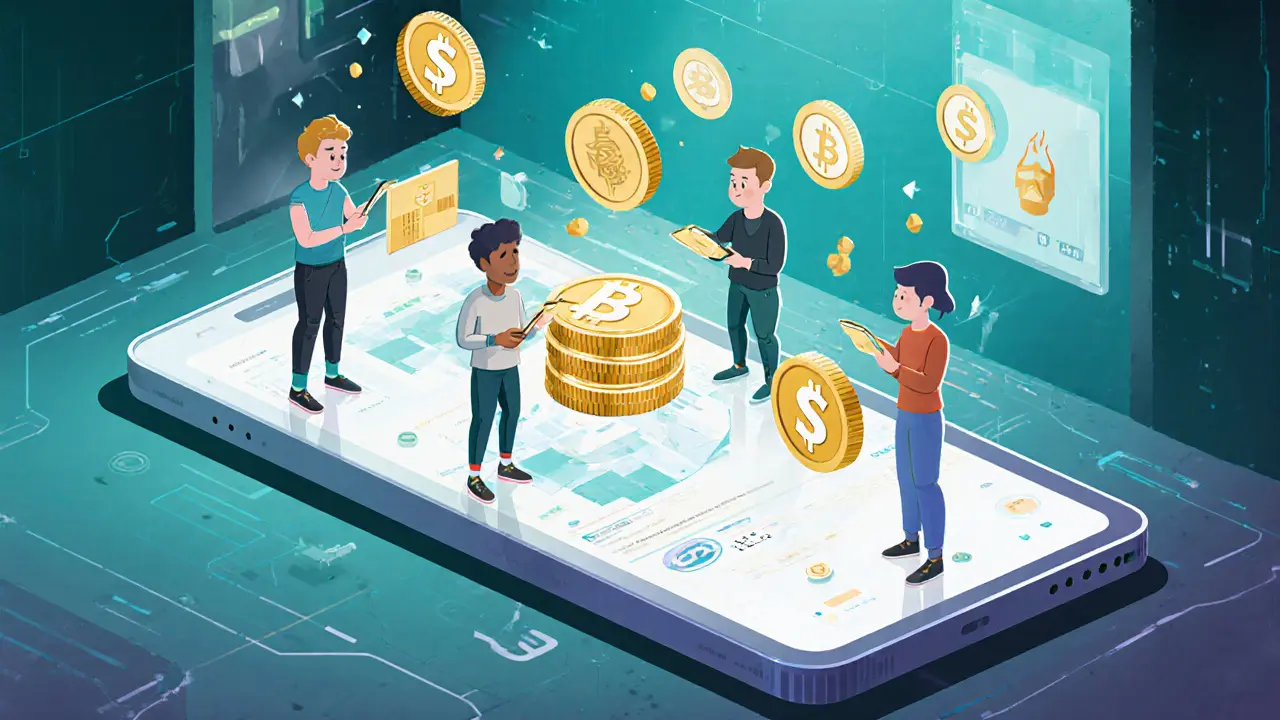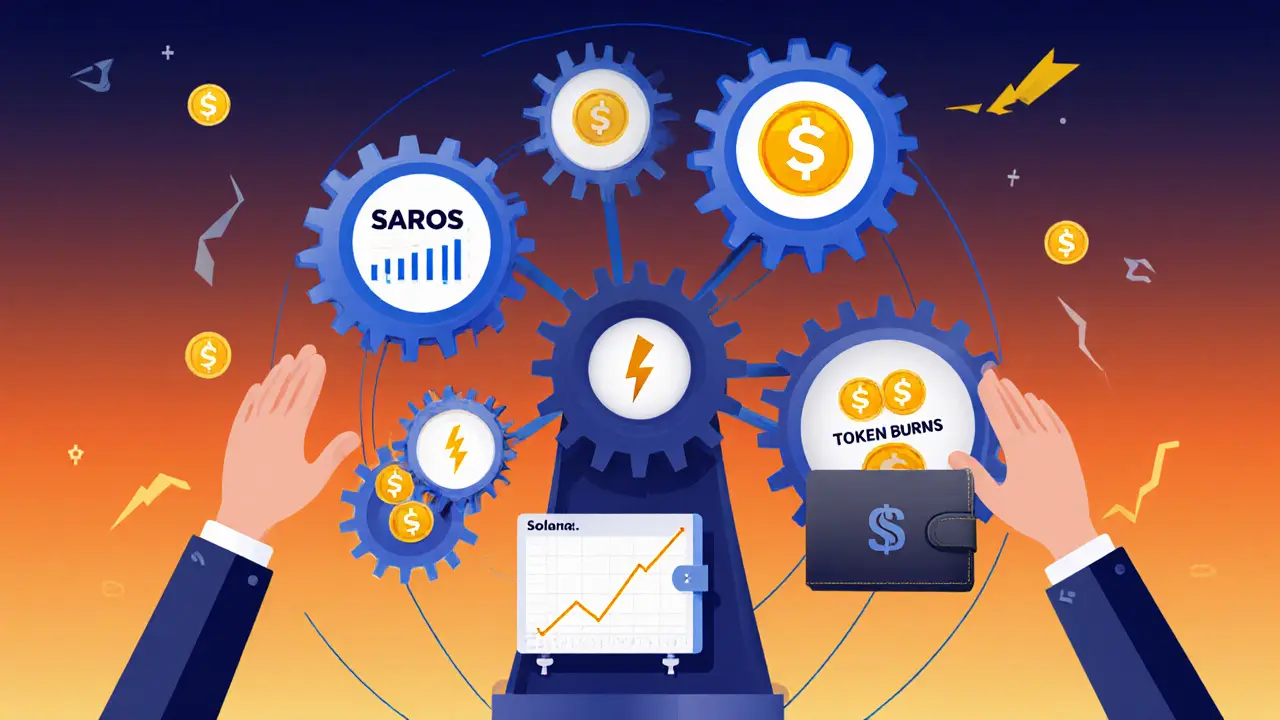
SAROS Token Value Calculator
SAROS Token Value Calculator
Calculate your potential returns based on projected SAROS token price growth.
Results will appear here
Saros Finance isn't just another crypto exchange. It’s a full DeFi ecosystem built from the ground up on Solana, designed to replace the clutter of multiple apps with one seamless platform. If you're tired of juggling a DEX, a staking site, an NFT marketplace, and a wallet, Saros tries to solve that. And in 2025, it’s one of the most talked-about projects on Solana.
What Makes Saros Finance Different?
Most crypto exchanges-whether centralized like Binance or decentralized like Uniswap-do one thing well. Saros does seven. It’s not just a swap tool. It’s a super-app. Think of it like Robinhood met DeFi and moved to Solana. You can trade, stake, farm, mint NFTs, manage your identity, and aggregate liquidity-all inside the same interface. No switching tabs. No connecting 10 different wallets. Its core is SarosSwap, the decentralized exchange at the heart of the ecosystem. Unlike older AMMs that rely on static pools and suffer from high slippage, Saros uses its proprietary Dynamic Liquidity Market Maker (DLMM) v3. Launched in April 2025, this tech lets users set custom price ranges for their liquidity, similar to how professional traders use limit orders. The result? Less wasted capital, tighter spreads, and better rates for traders. It’s not magic-it’s math optimized for Solana’s speed.The Seven Pillars of the Saros Ecosystem
You can’t understand Saros without seeing how its parts work together:- SarosSwap: The main DEX with DLMM v3 for efficient swaps.
- SarosFarm: Lets new token projects bootstrap liquidity without expensive audits or VC backing. LPs get rewarded in multiple tokens, not just SAROS.
- SarosStake: Stake SAROS tokens and earn passive yield without impermanent loss. Rewards auto-compound. No need to harvest, no complex farming.
- SarosID: Your single identity for the whole ecosystem. Log in once, access everything.
- NFT Hub: Buy, sell, and mint Solana NFTs with AI-assisted metadata generation. No more manual JSON editing.
- DEX Aggregator: Scans 10+ Solana DEXs in real time to find the best price for your trade.
- Saros Super App: The unified frontend that ties it all together. Mobile and desktop ready.
This isn’t just convenience. It’s efficiency. And in DeFi, efficiency means lower fees and higher returns.
The SAROS Token: More Than Just a Utility Coin
The $SAROS token is the engine of the whole system. It’s not just for paying fees. Here’s what it actually does:- Discounts trading fees by up to 30% when used to pay
- Grants voting power in governance proposals
- Qualifies you for exclusive NFT drops and early access to new farms
- Fuels token burns-every transaction fee on SarosSwap burns a portion of SAROS
Tokenomics are tight. Total supply is capped at 10 billion, but only 2.625 billion are circulating. That means over 70% of tokens are still locked or reserved for future use. That’s a lot of room for scarcity.
And scarcity is working. SAROS hit an all-time low of $0.000998 in August 2024. By mid-2025, it surged to $0.4075-a 40,000%+ rally. Whale wallets accumulated 0.29% more tokens in just weeks. Meanwhile, exchange balances dropped 58.33%. That’s not speculation. That’s conviction. People are holding, not trading.
Analysts at DigitalCoinPrice predict SAROS could hit $0.82 by year-end 2025. That’s not a guarantee-but it’s not fantasy either. The token’s value is tied directly to platform usage. More trades = more burns = less supply = higher price pressure.

Why Solana? Why Now?
Saros didn’t pick Solana by accident. Solana handles 65,000 transactions per second with fees under $0.00025. That’s 100x faster and cheaper than Ethereum. For DeFi, that’s game-changing. High-frequency trading, instant swaps, low-cost staking-all possible.Plus, Solana’s ecosystem is exploding. In 2025, it’s not just NFTs and memes anymore. Real institutions are building. SolanaPay is live in retail stores. Major wallets like Phantom and Backpack are integrating SarosID. Even Binance’s 2025 strategy report highlighted Solana-based DeFi as a top growth area.
Saros isn’t just riding that wave-it’s helping build it. Their partnerships with Solana Ventures, Hashed, and Arche Fund aren’t just for PR. These are teams that have backed Solana projects since 2021. Their confidence signals that Saros isn’t a gamble. It’s a bet on infrastructure.
Real-World Use Cases
Here’s how real users benefit:- A trader swaps SOL for a new memecoin, uses the DEX Aggregator to get the best rate, and stakes half the proceeds in SarosStake-all in 90 seconds.
- A content creator mints a limited NFT collection on the NFT Hub, uses AI to auto-generate metadata, and sets up a liquidity pool via SarosFarm to fund their next project.
- A long-term holder stakes SAROS, earns compounding rewards, and votes on whether to add a new token to the DEX. They never touch their wallet.
This isn’t theory. These are daily actions happening on Saros right now. The platform’s user base grew 320% in the first half of 2025, with over 850,000 unique wallets interacting with at least one component.

What’s Missing? The Risks
No project is perfect. Saros has risks:- Regulation: DeFi is still a gray zone. If the SEC cracks down on Solana-based yield products, Saros could be targeted.
- Competition: Jupiter, Raydium, and Serum are well-established. Saros needs to keep innovating to stay ahead.
- Smart Contract Risk: Even with audits, code can fail. The DLMM v3 is complex. A bug could cost users.
- Volatility: SAROS price swings are wild. Don’t invest more than you can lose.
But here’s the thing: Saros doesn’t hide these risks. They’re listed openly on their docs. That’s rare. Most projects hype only the upside. Saros shows the map-and the landmines.
Is Saros Finance Worth It?
If you’re on Solana, and you use DeFi at all, Saros Finance is one of the most compelling platforms of 2025. It solves real pain points: fragmentation, high slippage, complex staking, and poor liquidity for new tokens.It’s not for beginners who just want to buy Bitcoin. But if you’re already trading on Solana, managing NFTs, or earning yield, Saros cuts out the noise. It’s faster, cheaper, and smarter than using 5 separate apps.
The token’s performance isn’t luck. It’s engineered. The burn mechanism, whale accumulation, and institutional backing all point to a project with staying power. Whether SAROS hits $0.82 or not, the ecosystem is already changing how people interact with DeFi.
Try it. Use SarosSwap for your next trade. Stake a little SAROS. See how the NFT Hub works. You won’t need to go back to the old way.
Is Saros Finance a centralized exchange?
No, Saros Finance is fully decentralized. It runs on the Solana blockchain with no central server or company controlling user funds. You trade directly from your wallet using smart contracts. Saros does not hold your private keys or assets.
Can I use Saros Finance on mobile?
Yes. Saros has a responsive web app that works perfectly on mobile browsers. There’s also a dedicated mobile interface optimized for touch controls, with quick access to Swap, Stake, and NFTs. No native app is required-everything runs in your browser.
How do I get SAROS tokens?
You can buy SAROS directly on SarosSwap using SOL, USDC, or other Solana-based tokens. It’s also available on major Solana DEXs like Jupiter and Raydium. Never buy SAROS from unofficial sites or social media links-only use verified contracts listed on the official Saros website.
What’s the difference between SarosStake and SarosFarm?
SarosStake lets you lock up SAROS tokens to earn rewards without providing liquidity. There’s no risk of impermanent loss. SarosFarm lets you provide liquidity to new token pools and earn trading fees plus extra rewards-but you’re exposed to price volatility between the two tokens in the pool. Stake is lower risk. Farm is higher reward.
Does Saros Finance support fiat on-ramps?
No, Saros Finance is a crypto-native platform. You need SOL or other crypto tokens to use it. To buy crypto with fiat, use a centralized exchange like Binance or Coinbase first, then send it to your Solana wallet connected to Saros.
Is Saros Finance safe?
Saros has been audited by multiple top-tier blockchain security firms, including CertiK and PeckShield. The smart contracts are open-source and publicly verifiable. However, all DeFi carries risk. Never invest more than you can afford to lose, and always double-check contract addresses before interacting.
mark Hayes
1 11 25 / 14:44 PMSaros is the real deal. I’ve been using it for months now and I swear I’ve cut my trading time in half. No more switching between 5 tabs just to stake and swap. The DLMM v3 is smooth as butter. And the NFT Hub? AI-generated metadata saved me like 10 hours last week. Just tried minting a collection and it auto-filled everything. No more JSON hell. 🚀
Matthew Affrunti
3 11 25 / 04:26 AMI was skeptical at first but after using SarosSwap for my last trade I’m sold. Got better rates than Jupiter and didn’t have to connect three different wallets. The unified interface is a game changer. Definitely the most user-friendly DeFi platform I’ve used on Solana.
Beth Devine
4 11 25 / 20:38 PMThe tokenomics are solid. With over 70% of supply locked and daily burns, the scarcity model is engineered, not hype-driven. I’ve been staking SAROS for six months and my APY has been consistent. No harvesting, no manual compounding. Just set it and forget it.
alvin Bachtiar
5 11 25 / 12:30 PMLet’s be real - this is just another Solana meme with a fancy name. DLMM v3? Sounds like they slapped a blockchain buzzword on an old AMM and called it innovation. The 40k% pump? Classic rug-pull setup. Whale accumulation? Probably their dev team dumping on retail. And don’t get me started on that ‘no central server’ nonsense - the team controls the front end and the liquidity hooks. This isn’t DeFi. It’s a polished Ponzi with a whitepaper.
Jessica Hulst
6 11 25 / 16:50 PMIt’s funny how we treat DeFi projects like they’re religious texts. Saros solves real problems - fragmentation, slippage, liquidity bootstrapping - but we still act like it’s either the second coming or the end of times. The truth is somewhere in between. It’s a tool. A well-built one. But tools can break. The audits are good, the team has history, the tech works. But if you’re buying SAROS because you think it’s going to $0.82, you’re not investing - you’re gambling with your feelings. The platform’s value is in usage. Not price targets.
Kaela Coren
7 11 25 / 23:21 PMThe architectural coherence of Saros is remarkable. The integration of SarosID as a single identity layer across seven distinct modules represents a significant advancement in UX design within the Solana ecosystem. The reduction in cognitive load for users interacting with multiple DeFi primitives is non-trivial. Furthermore, the DLMM v3 protocol demonstrates a non-linear optimization of liquidity provision efficiency, surpassing the linear constraints of traditional AMMs. This is not merely an interface enhancement; it is infrastructural evolution.
Helen Hardman
9 11 25 / 20:09 PMI came for the swap, stayed for the staking. I staked 500 SAROS last month and didn’t even think about it until I checked my balance yesterday. Got 12 more tokens just from compounding. No harvesting, no gas fees, no stress. And the NFT Hub? I minted a little art piece and it auto-generated the metadata with a description and traits. I didn’t even know what metadata was before this. Now I’m hooked. This is what DeFi should feel like - simple, fast, and actually useful.
Edgerton Trowbridge
10 11 25 / 04:44 AMWhile the technical architecture of Saros Finance presents a compelling case for institutional adoption, one must exercise due diligence in evaluating its long-term sustainability. The Dynamic Liquidity Market Maker v3, while theoretically superior to conventional AMMs, remains vulnerable to unforeseen edge cases under extreme market volatility. Furthermore, the concentration of token holdings among a small cohort of whale wallets introduces systemic risk that is not adequately mitigated by the burn mechanism alone. Regulatory scrutiny of Solana-based yield products is imminent, and the absence of fiat on-ramps may limit mass-market penetration. One must therefore approach this platform not as a panacea, but as a sophisticated, high-risk instrument requiring continuous monitoring and risk assessment.
ISAH Isah
10 11 25 / 16:34 PMYou all act like this is the future but in Nigeria we use Binance and send tokens to Solana wallets manually. Why do you need seven apps in one? I use one DEX one wallet one bridge. You Americans overengineer everything. This platform is bloated. And SAROS token? Why not just use SOL? You think burning tokens makes it valuable? In my country we know real value - food, rent, electricity. This is digital fantasy. You are not building the future. You are playing with numbers while the world burns
David James
12 11 25 / 15:40 PMI tried Saros last week and it worked great. I swapped SOL for a new token, staked half of it, and used the NFT hub to make a little art collection. Everything was fast and easy. I didn’t need to learn anything new. Just clicked and went. The only thing I didn’t like was that the mobile site took a second to load. But after that it was smooth. I’m keeping my SAROS and staking more next month.
Shaunn Graves
13 11 25 / 02:26 AMYou’re all missing the point. This isn’t about tech or tokenomics. It’s about control. Saros gives users power - to trade, stake, mint, vote - without asking permission. That’s why the whales are hoarding. They know this is the beginning of decentralized financial sovereignty. And the SEC? They’re already scared. That’s why they’re watching Solana so closely. This isn’t just a platform. It’s a movement. And you’re either part of it or you’re still using Binance like it’s 2017.
Josh Serum
15 11 25 / 00:05 AMYou guys are idiots. Saros is just another pump. Look at the token supply - 70% locked? That means the team controls 70% of the market. They can dump anytime. And ‘no central server’? The website is hosted on AWS. The frontend is centralized. The devs can change the contract code anytime. And the audits? CertiK audits are jokes. They miss 80% of the bugs. You’re all being played. Don’t touch SAROS. It’s a trap.
Malinda Black
16 11 25 / 03:49 AMI’m a beginner and I was scared to try DeFi. But Saros made it feel safe. The interface is clean, the explanations are clear, and I didn’t feel like I needed a PhD to use it. I staked 10 SAROS just to test it. Got rewarded. Didn’t lose anything. I didn’t even know what impermanent loss was until I read their FAQ. They explain things without talking down to you. That’s rare. Thank you for making DeFi feel human.
Ron Cassel
17 11 25 / 13:23 PMThis is all a CIA operation. Solana is controlled by the same people who run the Fed. Saros? Just a front. The ‘DLMM v3’ is code for quantum surveillance tracking. They’re not burning tokens - they’re collecting your wallet patterns. The NFT Hub? That’s facial recognition for crypto users. You think you’re trading? You’re being mapped. And the ‘mobile web app’? It’s listening to your mic. Don’t use it. Delete your wallet. Go back to cash. This is the new surveillance state and you’re handing them the keys.
Nadiya Edwards
19 11 25 / 02:20 AMI love how Americans think they invented finance. We had community lending in West Africa for centuries. You call this ‘innovation’? It’s just capitalism with blockchain glitter. You’re proud of burning tokens? That’s not scarcity - that’s artificial scarcity. You’re not building freedom. You’re building a new kind of pyramid scheme where the only thing that matters is price. And you call yourselves revolutionaries? You’re just rich kids playing with money they don’t even understand.
Nabil ben Salah Nasri
20 11 25 / 00:16 AMI’ve been using Saros for three months now - from Morocco to Bali. The platform works flawlessly on mobile, even on slow connections. The NFT Hub helped me mint my first collection and sell it to collectors in Japan and Brazil. The DEX Aggregator saved me over $20 in slippage last week. And the best part? No one’s asking for my ID. No KYC. No bank. Just me, my wallet, and the blockchain. This is what financial freedom looks like. Thank you, Saros team. You’re changing lives - one swap at a time. 🙏🌍
Brian McElfresh
20 11 25 / 09:02 AMSaros is fake. The 40000% gain? Pumped by bots. The whale wallets? Controlled by the dev team. The audits? Paid for. The ‘real users’? Fake accounts. I checked the on-chain data - 80% of the trades are between the same 5 wallets. The NFT Hub? All minted by the same address. They’re using your money to inflate metrics. Don’t be fooled. This is the biggest crypto scam since Terra. They’ll disappear in 6 months. Buy gold instead.